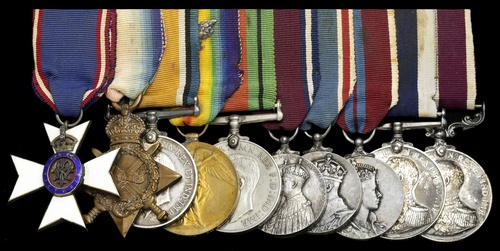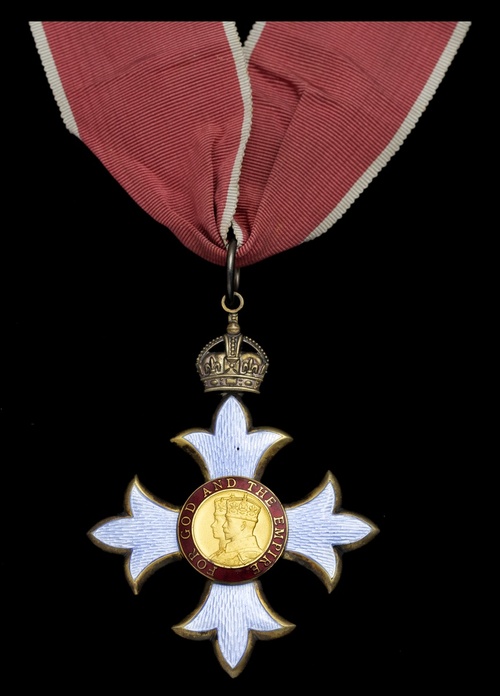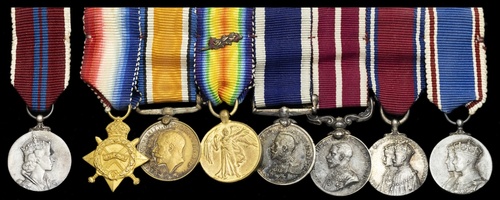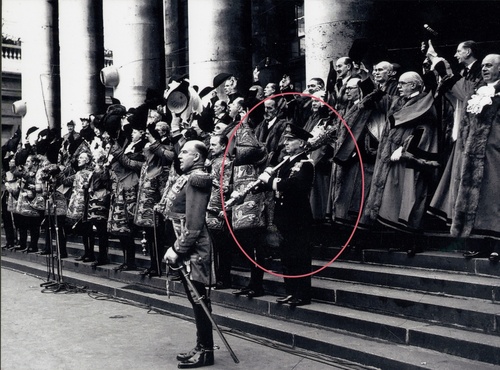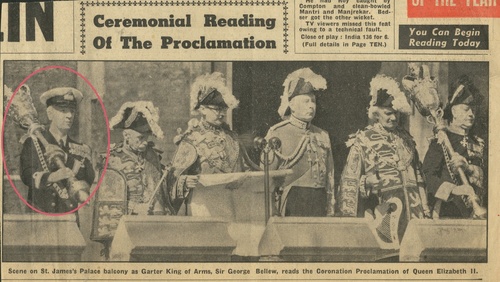Auction: 25001 - Orders, Decorations and Medals
Lot: 297
(x) The impressive C.B.E., M.V.O., M.S.M. group of eleven awarded to Lieutenant-Commander A. W. Stone, Royal Navy, who served at the Battle of Heligoland Blight, was twice 'mentioned' during the First World War, later Royal Household Assistant Secretary and Chief Accountant of the Privy Purse, Sergeant-at-Arms to King Geroge VI and Queen Elizabeth II, who carried the mace at Her Majesty's Coronation in 1953
The Most Excellent Order of the British Empire, Civil Division, 2nd Type Commander's (C.B.E.) neck Badge, by Garrard & Co., silver-gilt and enamel, on length of neck riband, in its case of issue; The Royal Victorian Order, 4th Class Member's (M.V.O.) breast Badge, by Collingwood Jewellers, reverse numbered '1526'; 1914-15 Star (346080, A. W. Stone, Wr. R.N.); British War and Victory Medals with M.I.D. oak leaves (346080 A. W. Stone Ch. Wr. R.N.); Defence Medal; Jubilee 1935; Coronation 1937; Coronation 1953; Royal Navy L.S. & G.C., G.V.R. (346080. A. W. Stone. Ch. Wtr. H.M.S. Cormorant.); Meritorious Service Medal, G.V.R. (346080. A. W. Stone, Ch. Wtr. "Curaco" Services During War.), mounted together as worn excluding C.B.E., some contact marks and a few lightly polished, otherwise very fine overall (11)
M.S.M. London Gazette 24 June 1919.
M.I.D. London Gazette 23 October 1914; 11 August 1917.
Albert William Stone was born on 20 June 1888 in Gosport, Hampshire, the third of four children born to Private Albert Stone and his wife Rebecca. Albert Stone Senior was a Private in the Portsmouth Division of the Royal Marine Light Infantry, later dying in the service at Portsea in 1892 after having taken part in the Witu Expedition in East Africa.
The younger Stone received a naval education and attended the Royal Hospital School at Greenwich, a school for the sons of poor sailors, where he learned navigation and seamanship skills. The school was known as the 'cradle of the Navy' for producing notable officers and personnel. He later enlisted into the Royal Navy in May 1903, when he was fifteen years old, as a Boy Writer with the H.M.S. Duke of Wellington naval barracks.
Stone enjoyed a number of postings, including aboard Majestic, Caesar, Firequeen, Victory, Hecla, Forward, and Skirmisher as he moved through the clerical ranks. Upon the outbreak of the First World War, he was serving as a Writer 1st Class aboard H.M.S. Amethyst. Stone was likely a member of Commodore Reginald Tyrwhitt's personal staff as he followed him nearly exactly from ship to ship, thus serving with a wide variety of Harwich Force cruisers during the War.
The Battle of Heligoland Bight on 28 August 1914 - the first naval battle of the War between the British and the Germans - saw Stone mentioned in dispatches for service during the action whilst aboard the light cruiser H.M.S. Arethusa. Arethusa was Tyrwhitt's flagship during the battle, and played an active role in the naval engagement. She helped to sink two German torpedo boats early that morning, and was badly damaged by the German defence. By the end of the day Britain scored a decisive victory, losing just 35 men to Germany's 1,500. Stone was still serving aboard Arethusa when she was mined off the coast of Felixstowe two years later on 11 February 1916, eventually running aground and breaking up.
He next served aboard H.M.S. Cleopatra while she served in the raid on the German naval airship base at Tondern, also sinking German destroyer G-194, before colliding with fellow naval ship Undaunted in March 1919. After repairs, she took part in operations against the German naval bombardment of Lowestoft in April 1916 and numbered one of Tyrwhitt's force that found the German cruisers carrying out the raid.
Stone thereafter joined the Harwich Force cruiser H.M.S. Carysfort in May 1916 when she was patrolling the North Sea and the Strait of Dover. This was but a brief appointment, and he was then with Centaur that September, also in the Harwich Force, and then on to her sister-ship H.M.S. Concord in February 1917. He was with her that June when she sank the German torpedo boat S20 in the North Sea. During this time, Stone was mentioned in despatches for the second time.
His final wartime posting was aboard H.M.S. Curacao, the flagship of the 5th cruiser squadron in the Harwich Force, where he earned his M.S.M. for war time services. After the close of the First World War, Stone joined H.M.S. Cormorant with whom he received his L.S. & G.C.. He was finally advanced to Chief Petty Officer Writer while serving with Victory II in 1924, and was later promoted Warrant Writer on 5 December 1927 upon his retirement from the service.
The exact date Stone was appointed to the Royal Household is not known, but he served in the office of the Privy Purse until his well-deserved retirement at age 69 in July 1957. He was appointed to the 5th Class of the Royal Victorian Order in January 1938 and was later promoted to the 4th Class in 1947, with the insignia being presented to him personally by King George VI. Stone was Chief Accountant but also acted as Serjeant-at-Arms under King George from 1947, and later for Queen Elizabeth II as well. He attended the Queen's Coronation in 1953, for which he carried the Mace as part of the Duke of Edinburgh's escort. He can be seen in the famous newsreel film of the event, as well as numerous photographs. Throughout his tenure with the Royal Household, Stone was awarded various foreign decorations from state visits and in January 1954 received his C.B.E..
His long and illustrious career in the Royal Navy was supplemented by an equally illustrious career for the Royal Household. Stone finally retired in 1957, and later died in Durham on 27 August 1974 at Woodside House, the home of his niece with whom he was residing.
Sold together with an original archive comprising:
i)
The recipient's dress miniatures: 1914-15 Star; British War and Victory Medals with M.I.D. oak leaves; Royal Navy L.S. & G.C., G.V.R.; M.S.M., G.V.R.; Jubilee 1935; Coronation 1937, mounted as worn, and Coronation 1953, mounted individually as worn, very fine (8) with some extra ribands
ii)
Fitted case for 4th Class M.V.O., by Collingwood Jewellers
iii)
Photo of Queen Elizabeth II with facsimile message and signature presented to Royal Household staff upon the occasion of her Coronation, framed but missing glass
iv)
The Illustrated London News, Coronation 1953 magazine with colour plates
v)
Booklet 'Statutes on the Order of the British Empire 1948'
vi)
Official Warrant for the appointment of 'Albert William Stone Esquire' to be Commander of the Order of the British Empire, signed by Queen Elizabeth and Prince Philip
vii)
Binder of comprehensive copied research and photographs, including a newspaper cutting of a photograph of Stone holding the Mace on the St. James's Palace Balcony as part of the Coronation ceremony, wearing his medals
Subject to 5% tax on Hammer Price in addition to 20% VAT on Buyer’s Premium.
Estimate
£800 to £1,200
Starting price
£600

